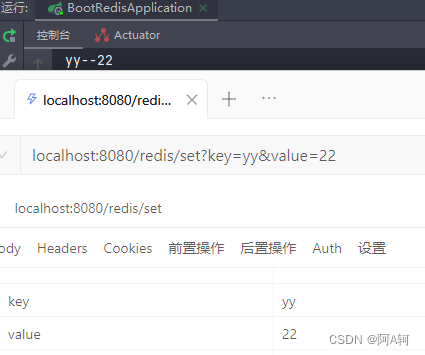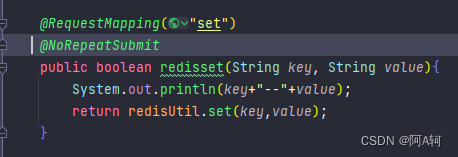1.redis的安装
redis下载 解压 安装
# wget http://download.redis.io/releases/redis-6.0.8.tar.gz
# tar xzf redis-6.0.8.tar.gz
# cd redis-6.0.8
# make看一下就会有![]()
进入redis-6.0.8下的src目录
[root@VM-16-8-centos redis]# cd redis-6.0.8
[root@VM-16-8-centos redis-6.0.8]# cd src
( src 目录下有编译后的 redis 服务程序 redis-server,还有用于测试的客户端程序 redis-cli:)
然后启动
# ./redis-server ../redis.conf
redis默认端口号 6379,建议更改。redis.conf是配置文件在 与src是同级目录。
要远程 #去掉保护模式,注释掉bind:127.0.0.1,protected-mode 改为no,
此外就是 redis 安全问题需要考虑,不然服务器会被入侵被挖矿 ,必须
#设置密码 requirepass 你的密码 (大约在 redis.conf 的 790 行)
设置密码后 ,启动 redis 服务进程后,就可以使用测试客户端程序 redis-cli 和 redis 服务交互了
./redis.cli -p 端口号 -a 你的密码2.SpringBoot整合redis
首先 IDEA 创建好一个SpringBoot 的 web 项目。
1.导入依赖:
<dependency>
<groupId>org.springframework.boot</groupId>
<artifactId>spring-boot-starter-data-redis</artifactId>
</dependency>2.新建application.yml配置
spring:
redis:
# Redis本地服务器地址,注意要开启redis服务,即那个redis-server.exe
host: 你的服务器地址
# Redis服务器端口,默认为6379.若有改动按改动后的来
port: 端口号
#Redis服务器连接密码,默认为空,若有设置按设置的来
password: 密码
lettuce:
pool:
# 连接池最大连接数,若为负数则表示没有任何限制
max-active: 8
# 连接池最大阻塞等待时间,若为负数则表示没有任何限制
max-wait: -1
# 连接池中的最大空闲连接
max-idle: 83.redis配置类-直接用
import com.fasterxml.jackson.annotation.JsonAutoDetect;
import com.fasterxml.jackson.annotation.PropertyAccessor;
import com.fasterxml.jackson.databind.ObjectMapper;
import org.springframework.cache.annotation.CachingConfigurerSupport;
import org.springframework.cache.annotation.EnableCaching;
import org.springframework.context.annotation.Bean;
import org.springframework.context.annotation.Configuration;
import org.springframework.data.redis.connection.RedisConnectionFactory;
import org.springframework.data.redis.core.*;
import org.springframework.data.redis.serializer.Jackson2JsonRedisSerializer;
import org.springframework.data.redis.serializer.StringRedisSerializer;
/**
* redis配置类
*/
@Configuration
@EnableCaching //开启注解
public class RedisConfig extends CachingConfigurerSupport {
/**
* retemplate相关配置
*/
@Bean
public RedisTemplate<String, Object> redisTemplate(RedisConnectionFactory factory) {
RedisTemplate<String, Object> template = new RedisTemplate<>();
// 配置连接工厂
template.setConnectionFactory(factory);
//使用Jackson2JsonRedisSerializer来序列化和反序列化redis的value值(默认使用JDK的序列化方式)
Jackson2JsonRedisSerializer jacksonSeial = new Jackson2JsonRedisSerializer(Object.class);
ObjectMapper om = new ObjectMapper();
// 指定要序列化的域,field,get和set,以及修饰符范围,ANY是都有包括private和public
om.setVisibility(PropertyAccessor.ALL, JsonAutoDetect.Visibility.ANY);
// 指定序列化输入的类型,类必须是非final修饰的,final修饰的类,比如String,Integer等会跑出异常
om.enableDefaultTyping(ObjectMapper.DefaultTyping.NON_FINAL);
jacksonSeial.setObjectMapper(om);
// 值采用json序列化
template.setValueSerializer(jacksonSeial);
//使用StringRedisSerializer来序列化和反序列化redis的key值
template.setKeySerializer(new StringRedisSerializer());
// 设置hash key 和value序列化模式
template.setHashKeySerializer(new StringRedisSerializer());
template.setHashValueSerializer(jacksonSeial);
template.afterPropertiesSet();
return template;
}
/**
* 对hash类型的数据操作
*/
@Bean
public HashOperations<String, String, Object> hashOperations(RedisTemplate<String, Object> redisTemplate) {
return redisTemplate.opsForHash();
}
/**
* 对redis字符串类型数据操作
*/
@Bean
public ValueOperations<String, Object> valueOperations(RedisTemplate<String, Object> redisTemplate) {
return redisTemplate.opsForValue();
}
/**
* 对链表类型的数据操作
*/
@Bean
public ListOperations<String, Object> listOperations(RedisTemplate<String, Object> redisTemplate) {
return redisTemplate.opsForList();
}
/**
* 对无序集合类型的数据操作
*/
@Bean
public SetOperations<String, Object> setOperations(RedisTemplate<String, Object> redisTemplate) {
return redisTemplate.opsForSet();
}
/**
* 对有序集合类型的数据操作
*/
@Bean
public ZSetOperations<String, Object> zSetOperations(RedisTemplate<String, Object> redisTemplate) {
return redisTemplate.opsForZSet();
}
}4.redis工具类-直接用
import org.springframework.beans.factory.annotation.Autowired;
import org.springframework.data.redis.core.RedisTemplate;
import org.springframework.stereotype.Component;
import org.springframework.util.CollectionUtils;
import java.util.Collection;
import java.util.List;
import java.util.Map;
import java.util.Set;
import java.util.concurrent.TimeUnit;
@Component
public class RedisUtil {
@Autowired
private RedisTemplate<String, Object> redisTemplate;
public RedisUtil(RedisTemplate<String, Object> redisTemplate) {
this.redisTemplate = redisTemplate;
}
/**
* 指定缓存失效时间
* @param key 键
* @param time 时间(秒)
* @return
*/
public boolean expire(String key,long time){
try {
if(time>0){
redisTemplate.expire(key, time, TimeUnit.SECONDS);
}
return true;
} catch (Exception e) {
e.printStackTrace();
return false;
}
}
/**
* 根据key 获取过期时间
* @param key 键 不能为null
* @return 时间(秒) 返回0代表为永久有效
*/
public long getExpire(String key){
return redisTemplate.getExpire(key,TimeUnit.SECONDS);
}
/**
* 判断key是否存在
* @param key 键
* @return true 存在 false不存在
*/
public boolean hasKey(String key){
try {
return redisTemplate.hasKey(key);
} catch (Exception e) {
e.printStackTrace();
return false;
}
}
/**
* 删除缓存
* @param key 可以传一个值 或多个
*/
@SuppressWarnings("unchecked")
public void del(String ... key){
if(key!=null&&key.length>0){
if(key.length==1){
redisTemplate.delete(key[0]);
}else{
redisTemplate.delete((Collection<String>) CollectionUtils.arrayToList(key));
}
}
}
//============================String=============================
/**
* 普通缓存获取
* @param key 键
* @return 值
*/
public Object get(String key){
return key==null?null:redisTemplate.opsForValue().get(key);
}
/**
* 普通缓存放入
* @param key 键
* @param value 值
* @return true成功 false失败
*/
public boolean set(String key,Object value) {
try {
redisTemplate.opsForValue().set(key, value);
return true;
} catch (Exception e) {
e.printStackTrace();
return false;
}
}
/**
* 普通缓存放入并设置时间
* @param key 键
* @param value 值
* @param time 时间(秒) time要大于0 如果time小于等于0 将设置无限期
* @return true成功 false 失败
*/
public boolean set(String key,Object value,long time){
try {
if(time>0){
redisTemplate.opsForValue().set(key, value, time, TimeUnit.SECONDS);
}else{
set(key, value);
}
return true;
} catch (Exception e) {
e.printStackTrace();
return false;
}
}
/**
* 递增
* @param key 键
* @param delta 要增加几(大于0)
* @return
*/
public long incr(String key, long delta){
if(delta<0){
throw new RuntimeException("递增因子必须大于0");
}
return redisTemplate.opsForValue().increment(key, delta);
}
/**
* 递减
* @param key 键
* @param delta 要减少几(小于0)
* @return
*/
public long decr(String key, long delta){
if(delta<0){
throw new RuntimeException("递减因子必须大于0");
}
return redisTemplate.opsForValue().increment(key, -delta);
}
//================================Map=================================
/**
* HashGet
* @param key 键 不能为null
* @param item 项 不能为null
* @return 值
*/
public Object hget(String key,String item){
return redisTemplate.opsForHash().get(key, item);
}
/**
* 获取hashKey对应的所有键值
* @param key 键
* @return 对应的多个键值
*/
public Map<Object,Object> hmget(String key){
return redisTemplate.opsForHash().entries(key);
}
/**
* HashSet
* @param key 键
* @param map 对应多个键值
* @return true 成功 false 失败
*/
public boolean hmset(String key, Map<String,Object> map){
try {
redisTemplate.opsForHash().putAll(key, map);
return true;
} catch (Exception e) {
e.printStackTrace();
return false;
}
}
/**
* HashSet 并设置时间
* @param key 键
* @param map 对应多个键值
* @param time 时间(秒)
* @return true成功 false失败
*/
public boolean hmset(String key, Map<String,Object> map, long time){
try {
redisTemplate.opsForHash().putAll(key, map);
if(time>0){
expire(key, time);
}
return true;
} catch (Exception e) {
e.printStackTrace();
return false;
}
}
/**
* 向一张hash表中放入数据,如果不存在将创建
* @param key 键
* @param item 项
* @param value 值
* @return true 成功 false失败
*/
public boolean hset(String key,String item,Object value) {
try {
redisTemplate.opsForHash().put(key, item, value);
return true;
} catch (Exception e) {
e.printStackTrace();
return false;
}
}
/**
* 向一张hash表中放入数据,如果不存在将创建
* @param key 键
* @param item 项
* @param value 值
* @param time 时间(秒) 注意:如果已存在的hash表有时间,这里将会替换原有的时间
* @return true 成功 false失败
*/
public boolean hset(String key,String item,Object value,long time) {
try {
redisTemplate.opsForHash().put(key, item, value);
if(time>0){
expire(key, time);
}
return true;
} catch (Exception e) {
e.printStackTrace();
return false;
}
}
/**
* 删除hash表中的值
* @param key 键 不能为null
* @param item 项 可以使多个 不能为null
*/
public void hdel(String key, Object... item){
redisTemplate.opsForHash().delete(key,item);
}
/**
* 判断hash表中是否有该项的值
* @param key 键 不能为null
* @param item 项 不能为null
* @return true 存在 false不存在
*/
public boolean hHasKey(String key, String item){
return redisTemplate.opsForHash().hasKey(key, item);
}
/**
* hash递增 如果不存在,就会创建一个 并把新增后的值返回
* @param key 键
* @param item 项
* @param by 要增加几(大于0)
* @return
*/
public double hincr(String key, String item,double by){
return redisTemplate.opsForHash().increment(key, item, by);
}
/**
* hash递减
* @param key 键
* @param item 项
* @param by 要减少记(小于0)
* @return
*/
public double hdecr(String key, String item,double by){
return redisTemplate.opsForHash().increment(key, item,-by);
}
//============================set=============================
/**
* 根据key获取Set中的所有值
* @param key 键
* @return
*/
public Set<Object> sGet(String key){
try {
return redisTemplate.opsForSet().members(key);
} catch (Exception e) {
e.printStackTrace();
return null;
}
}
/**
* 根据value从一个set中查询,是否存在
* @param key 键
* @param value 值
* @return true 存在 false不存在
*/
public boolean sHasKey(String key,Object value){
try {
return redisTemplate.opsForSet().isMember(key, value);
} catch (Exception e) {
e.printStackTrace();
return false;
}
}
/**
* 将数据放入set缓存
* @param key 键
* @param values 值 可以是多个
* @return 成功个数
*/
public long sSet(String key, Object...values) {
try {
return redisTemplate.opsForSet().add(key, values);
} catch (Exception e) {
e.printStackTrace();
return 0;
}
}
/**
* 将set数据放入缓存
* @param key 键
* @param time 时间(秒)
* @param values 值 可以是多个
* @return 成功个数
*/
public long sSetAndTime(String key,long time,Object...values) {
try {
Long count = redisTemplate.opsForSet().add(key, values);
if(time>0) {
expire(key, time);
}
return count;
} catch (Exception e) {
e.printStackTrace();
return 0;
}
}
/**
* 获取set缓存的长度
* @param key 键
* @return
*/
public long sGetSetSize(String key){
try {
return redisTemplate.opsForSet().size(key);
} catch (Exception e) {
e.printStackTrace();
return 0;
}
}
/**
* 移除值为value的
* @param key 键
* @param values 值 可以是多个
* @return 移除的个数
*/
public long setRemove(String key, Object ...values) {
try {
Long count = redisTemplate.opsForSet().remove(key, values);
return count;
} catch (Exception e) {
e.printStackTrace();
return 0;
}
}
//===============================list=================================
/**
* 获取list缓存的内容
* @param key 键
* @param start 开始
* @param end 结束 0 到 -1代表所有值
* @return
*/
public List<Object> lGet(String key, long start, long end){
try {
return redisTemplate.opsForList().range(key, start, end);
} catch (Exception e) {
e.printStackTrace();
return null;
}
}
/**
* 获取list缓存的长度
* @param key 键
* @return
*/
public long lGetListSize(String key){
try {
return redisTemplate.opsForList().size(key);
} catch (Exception e) {
e.printStackTrace();
return 0;
}
}
/**
* 通过索引 获取list中的值
* @param key 键
* @param index 索引 index>=0时, 0 表头,1 第二个元素,依次类推;index<0时,-1,表尾,-2倒数第二个元素,依次类推
* @return
*/
public Object lGetIndex(String key,long index){
try {
return redisTemplate.opsForList().index(key, index);
} catch (Exception e) {
e.printStackTrace();
return null;
}
}
/**
* 将list放入缓存
* @param key 键
* @param value 值
* @return
*/
public boolean lSet(String key, Object value) {
try {
redisTemplate.opsForList().rightPush(key, value);
return true;
} catch (Exception e) {
e.printStackTrace();
return false;
}
}
/**
* 将list放入缓存
* @param key 键
* @param value 值
* @param time 时间(秒)
* @return
*/
public boolean lSet(String key, Object value, long time) {
try {
redisTemplate.opsForList().rightPush(key, value);
if (time > 0) {
expire(key, time);
}
return true;
} catch (Exception e) {
e.printStackTrace();
return false;
}
}
/**
* 将list放入缓存
* @param key 键
* @param value 值
* @return
*/
public boolean lSet(String key, List<Object> value) {
try {
redisTemplate.opsForList().rightPushAll(key, value);
return true;
} catch (Exception e) {
e.printStackTrace();
return false;
}
}
/**
* 将list放入缓存
* @param key 键
* @param value 值
* @param time 时间(秒)
* @return
*/
public boolean lSet(String key, List<Object> value, long time) {
try {
redisTemplate.opsForList().rightPushAll(key, value);
if (time > 0) {
expire(key, time);
}
return true;
} catch (Exception e) {
e.printStackTrace();
return false;
}
}
/**
* 根据索引修改list中的某条数据
* @param key 键
* @param index 索引
* @param value 值
* @return
*/
public boolean lUpdateIndex(String key, long index,Object value) {
try {
redisTemplate.opsForList().set(key, index, value);
return true;
} catch (Exception e) {
e.printStackTrace();
return false;
}
}
/**
* 移除N个值为value
* @param key 键
* @param count 移除多少个
* @param value 值
* @return 移除的个数
*/
public long lRemove(String key,long count,Object value) {
try {
Long remove = redisTemplate.opsForList().remove(key, count, value);
return remove;
} catch (Exception e) {
e.printStackTrace();
return 0;
}
}
}5.写Controller测试
import com.qcby.bootredis.NoRepeatSubmit;
import com.qcby.bootredis.util.RedisUtil;
import lombok.extern.slf4j.Slf4j;
import org.springframework.web.bind.annotation.RequestMapping;
import org.springframework.web.bind.annotation.RestController;
import javax.annotation.Resource;
@Slf4j
@RequestMapping("/redis")
@RestController
public class RedisController {
@Resource
private RedisUtil redisUtil;
@RequestMapping("set")
// @NoRepeatSubmit
public boolean redisset(String key, String value){
System.out.println(key+"--"+value);
return redisUtil.set(key,value);
}
@RequestMapping("get")
public Object redisget(String key){
System.out.println(redisUtil.get(key));
return redisUtil.get(key);
}
@RequestMapping("expire")
public boolean expire(String key,long ExpireTime){
return redisUtil.expire(key,ExpireTime);
}
}
6.启动redis,启动程序,存个数据,测试结果

拿个数据:

redis中:
![]()
3.整合AOP,防止重复提交
一,定义注解。
定义一个锁住接口时间的方法,默认值为5。
import java.lang.annotation.*;
@Documented
@Target({ElementType.TYPE,ElementType.METHOD})
@Retention(RetentionPolicy.RUNTIME)
public @interface NoRepeatSubmit {
int lockTime() default 5;
}二,写一个HttpContextUtil工具类获取HttpServletRequest请求
import org.springframework.web.context.request.RequestContextHolder;
import org.springframework.web.context.request.ServletRequestAttributes;
import javax.servlet.http.HttpServletRequest;
import java.util.Objects;
public class HttpContextUtils {
public static HttpServletRequest HttpServletRequest(){
return ((ServletRequestAttributes) Objects.requireNonNull(RequestContextHolder.getRequestAttributes())).getRequest();
}
}三,定义一个切面
采用的方案是Redis来缓存提交接口的唯一标识,然后设置过期时间。
唯一标识使用接口的URL和用户的token组合在一起的方式使达到唯一。用户每发起第一次添加请求,会经过界面,在切面获取信息后组装起来存入Redis,当用户后续发起请求时,首先判断Redis中是否缓存了这个key,如果缓存了,则证明已经提交,于是反馈给前端,如果不存在,证明没有提交,则存入Redis。
@Component
@Aspect
public class NoRepeatSubmitAspect {
@Autowired
private RedisTemplate<String,Object> redisTemplate;
@Pointcut("@annotation(repeatSubmit)")
public void pointcutNoRepeat(NoRepeatSubmit repeatSubmit){};
@Around("pointcutNoRepeat(noRepeatSubmit)")
public Object doNoRepeat(ProceedingJoinPoint point,NoRepeatSubmit noRepeatSubmit) throws Throwable {
int i=noRepeatSubmit.lockTime();
HttpServletRequest httpServletRequest = HttpContextUtils.HttpServletRequest();
String token = httpServletRequest.getHeader("token");
String url = httpServletRequest.getRequestURL().toString();
String sign = url+"/"+token;
Boolean key=redisTemplate.hasKey(sign);
if (key){
throw new Exception("请勿重复提交");
}
redisTemplate.opsForValue().set(sign,sign,i,TimeUnit.SECONDS);
return point.proceed();
}
}如果key存在抛出异常。
@Aspect:声明这是一个切面类(使用时需要与@Component注解一起用,表明同时将该类交给spring管理)
@pointcut(@annotation)是Spring AOP中的一个注解,它可以用来指定一个切点,该切点选择所有带有特定注解的方法或类。例如,如果我们想要记录所有带有@Log注解的方法的日志,我们可以定义一个切点,使用@pointcut(@annotation(Log.class)注解来选择这些方法。
@Around 环绕通知
point.proceed():
- 环绕通知 ProceedingJoinPoint 执行proceed方法的作用是让目标方法执行,这也是环绕通知和前置、后置通知方法的一个最大区别。
- 简单理解,环绕通知=前置+目标方法执行+后置通知,proceed方法就是用于启动目标方法执行的.
四。之前方法上加上我们的注解






















 2万+
2万+











 被折叠的 条评论
为什么被折叠?
被折叠的 条评论
为什么被折叠?








